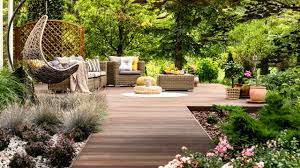The Art of Landscaping: Creating Beautiful Outdoor Retreats
A meticulously planned landscape has the ability to convert an outdoor area into an aesthetically pleasing sanctuary, a haven from the pressures and obligations of daily existence. Beyond mere maintenance tasks such as grass pruning and flower planting, the art of landscaping entails a masterful fusion of ingenuity, practicality, and ecological awareness. This guide will examine the components that comprise the art of horticulture, including sustainable practices and design principles, in an effort to assist you in creating a lovely outdoor retreat.
The Fundamentals of Landscape Structure
Prior to exploring the intricacies of horticulture, it is critical to grasp the foundational principles that govern the craft. These principles function as the bedrock for establishing aesthetically appealing and harmonious outdoor environments.
Oneness
Unity in landscaping pertains to the synchronized and harmonious configuration of components throughout one’s outdoor environment. It entails establishing a sense of equilibrium and unity through the application of consistent colors, patterns, and themes. By ensuring that your landscape appears as a unified whole and not as a collection of disparate elements, unity guarantees this.
Balance
The distribution of visual weight in a landscape constitutes its equilibrium. Two varieties of balance exist: asymmetrical and symmetrical. By mirroring elements on either side of a central axis, symmetrical balance produces an appearance that is formal and organized. Conversely, asymmetrical balance entails the deliberate arrangement and selection of dissimilar elements in order to achieve equilibrium, thereby yielding an appearance that is more casual and unpretentious.
Proportion and Scale
Scale and proportionality are fundamental elements of design. The concept of proportion pertains to the relationship in scale between various components, including structures, hardscapes, and plants. Conversely, scale pertains to the proportions of these components with respect to the entirety of the landscape. It is vital to maintain proportion and scale in order to create an aesthetically appealing landscape.
Repetition and Symbolism
By employing patterns and recurring elements, rhythm and repetition impart a sense of motion and fluidity to a landscape. Utilizing similar plants, colors, or shapes can establish repetition, whereas the arrangement of elements that direct the eye through the space can generate rhythm.
Areas of Focus
Focal points are conspicuous landscape elements that generate visual fascination and attract attention. An aesthetically pleasing tree or plant, a sculpture, or even a water feature can all serve as effective focal points. Focal points provide direction and serve to anchor the design.
Constructing Exterior Retreats
Following an examination of landscape design fundamentals, we shall now delve into the craft of constructing aesthetically pleasing outdoor retreats. In addition to aesthetics, these areas are created to promote relaxation, enjoyment, and functionality.
Establish Your Vision
Vision clarification is the initial stage in designing an outdoor retreat. What are your intended objectives for your outdoor area? Can you picture yourself in a serene oasis for contemplation, a lively entertainment area for organizing gatherings, or a comfortable garden nook designated for reading? Your objectives will provide direction for the design process.
Choose Appropriate Plants
Plants are the foundation of any landscape, so it is vital to select the proper ones. Climate, soil conditions, and maintenance needs should all be taken into account when choosing flora for an outdoor retreat. Native plants are frequently an excellent option due to their low maintenance requirements and adaptation to the local environment.
Integrate Hardscape Components
Hardscape components, including walls, walkways, and patios, give your outdoor space structure and functionality. These components delineate boundaries, pathways, and seating locations. Select designs and materials that harmonize with the aesthetic of your retreat as a whole.
Establish Convenient Seating
It is critical to have comfortable furnishings at any outdoor retreat. Seating options, including a hammock, a comfortable bench beneath a tree, or a collection of fashionable outdoor furniture, all encourage relaxation and pleasure. When selecting seating, aesthetics and comfort should both be considered.
Include Water Functions
Fountains, ponds, and waterways are examples of water features that can contribute to the tranquility of an outdoor retreat. Flowing water can contribute to a tranquil atmosphere, while fish and aquatic vegetation enhance the aesthetic value. Additionally, fauna is drawn to water features, which increases the biodiversity of your landscape.
Integrate Illumination
Having outdoor illumination allows you to utilize your retreat well into the evening. Alternate between task, accent, and ambient illumination to produce distinct ambiances and accentuate prominent attributes. LED and solar-powered illumination alternatives are environmentally friendly and energy-efficient.
Strengthen Privacy
In many cases, privacy is an essential component of outdoor retreats. In order to establish a secluded ambiance, it might be necessary to integrate privacy screens, trellises, or vegetation, contingent upon the specific locality and environment. Climbing vines, bamboo, or tall hedges can serve as natural privacy barriers.
Adopt Sustainable Methodologies
Sustainability is a critical component of contemporary landscaping design. Adopt environmentally conscious practices, including the utilization of native plants, the installation of efficient irrigation systems to reduce water usage, and the selection of permeable hardscape materials to mitigate discharge. Additionally to being environmentally friendly, sustainable landscaping reduces long-term maintenance expenses.
Preserve Your Retreat
Following the completion of your outdoor retreat, routine maintenance will ensure that it continues to be a functional and aesthetically pleasing space. This encompasses activities such as plant pruning, water feature cleaning, and wear and tear restoration. Consistent upkeep safeguards the durability and liveliness of one’s landscaping.
Landscaping Services is Recommended
Although constructing an outdoor retreat can be a gratifying do-it-yourself endeavor for landscaping companies in Holland, it is critical to remember that horticulture frequently necessitates a blend of ingenuity, aptitude, and material assets. Hence, it is strongly advised to contemplate the employment of expert landscaping services. Skilled landscapers possess the ability to materialize your vision by considering design principles and the particular requirements of your outdoor area. Their knowledge and access to an extensive variety of materials and flora can guarantee that your retreat is not only aesthetically pleasing but also environmentally friendly and practical.
In summary, landscaping is an artistic endeavor that provides the opportunity to convert an outdoor area into an aesthetically pleasing sanctuary. You can create a tranquil and joyful outdoor sanctuary by comprehending the fundamentals of landscape architecture, establishing your vision, choosing the appropriate components, and adopting sustainable methods. Whether you elect to undertake this endeavor on your own or with the assistance of professional landscaping services, the end result will be an exquisite outdoor sanctuary that augments the aesthetic appeal and practicality of your property, click here to learn more.






